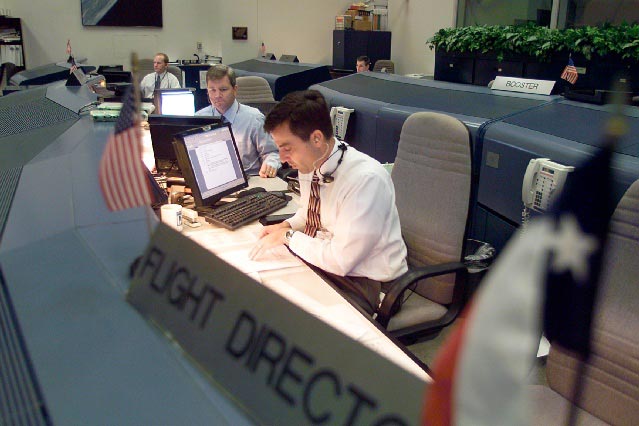Launch Anticipation: Mixed Feelings About Discovery’s Flight

CAPE CANAVERAL, Fla.– As NASA standspoised to launch its first shuttle mission in more than two years, a mixture ofboth excitement and apprehension fill the hearts of some of those watching overthe upcoming space shot.
Weatherpermitting, the space shuttle Discovery is set to launch Wednesday afternoon ona mission to put seven astronauts in orbit and show that NASA has once againovercome tragedy in pursuit of space exploration. The mission is the firstscheduled shuttle flight since the 2003 accident that resulted in the loss ofthe Columbiaorbiter and its entire astronaut crew during STS-107.
“I feellike it’s time,” Doug Brown, brother of STS-107 mission specialistDavid Brown told SPACE.com in atelephone interview. “It’s a chance to refocus and sort of reaffirmthat we know why and what we’re doing.”
The spaceshuttle Columbiabroke apart during reentry on Feb. 1, 2003 after a successful 16-day sciencemission. The accident ground NASA’s shuttle program to a halt whileinvestigators traced its cause, ultimately pinning the incident on foaminsulation debris that struck Columbia’sleft wing and punched hole in the orbiter’s protective, heat-resistantskin. Over the last two and a half years NASA has strived to reduce the chanceof such an accident occurring again, redesigning shuttle external tanks toprevent the loss of foam like that which doomed Columbia, as well as potentially harmful ice.
The resultis Discovery’s STS-114 mission, a test flight designed to not only verifyNASA’s external tank modifications, but evaluate a new orbital inspectionboom and other tools tailored for thermal protection system repair. NASA hopesto launch Discovery on a 12-day flight at about 3:51 p.m. EDT (1951 GMT). Thelaunch countdown has been ticking away since Sunday, and only the threat ofafternoon thunderstorms cloud the space shot’s prospects, NASA officialssaid.
“Flyingin this morning, we saw the vehicle on the pad and it absolutely struck me thatwe’re back to spaceflight,” astronaut David Wolf, head of the EVAbranch at NASA’s Astronaut Office, told SPACE.com here Monday at NASA’s Kennedy Space Center. “There’sa real excitement here, and of course a mixed tension coming off an accident.”
A veteranof four shuttle flights and one long-duration stint aboard the Russian spacestation Mir, Wolf said that observers on the ground have a harder time atlaunch than the astronauts seated inside a shuttle’s crew compartment.
Get the Space.com Newsletter
Breaking space news, the latest updates on rocket launches, skywatching events and more!
“Somehow,with your friends in there and people you know, it’s always scarier thanwhen you’re in it,” he said. “Italways completely captures me to see a shuttle launch.”
Discovery’sflight is the first of two test missions to evaluate post-Columbia changes inthe shuttle launch system to lower flight risks to what NASA officials havecalled an “acceptable” level.
“Davidwas very big on the [space] program…so it must go on,” Brown said,adding that his brother, like himself, was aware of the risks of humanspaceflight. “I don’t have a problem in that it’s risky andwe’re going to choose to accept risk. While it’s painful thatit’s my family that’s affected, it’s inherent to thebusiness.”
Like manyin NASA, the loss of the STS-107 astronauts has not left the mind of Paul Hill,lead flight director for the STS-114 mission, who has spent the last six daystying up loose ends at Johnson Space Centerin Houstonwhere the spaceflight will be coordinated after Discovery reaches orbit.
“Therearen’t many days that I don’t drive into work and not think of theaccident, it’s something that creeps back,” Hill said in atelephone interview. “But this is a tough job and during the mission weowe it to Eileen and her crew to have our eye on the ball.
“Whenit’s over, when I’m walking out of the control room, I’ll bethinking about Rick [Husband],” Hill said of Columbia’s last commander.
Hill saidDiscovery’s spaceflight, and ultimately the rest of the orbiter missionsset to complete the International Space Station, are pivotal to the future ofNASA’s plans for the human exploration of space.
“Wearen’t here to keep doing roundy-rounds inEarth orbit,” Hill said. “We are here to push outward. I want,someday, to know that humanity will leave the solar system, and you don’tget any closer staying in low Earth orbit.”
- Fixing NASA: Complete Coverage of Space Shuttle Return to Flight
Join our Space Forums to keep talking space on the latest missions, night sky and more! And if you have a news tip, correction or comment, let us know at: community@space.com.

Tariq is the Editor-in-Chief of Space.com and joined the team in 2001, first as an intern and staff writer, and later as an editor. He covers human spaceflight, exploration and space science, as well as skywatching and entertainment. He became Space.com's Managing Editor in 2009 and Editor-in-Chief in 2019. Before joining Space.com, Tariq was a staff reporter for The Los Angeles Times covering education and city beats in La Habra, Fullerton and Huntington Beach. In October 2022, Tariq received the Harry Kolcum Award for excellence in space reporting from the National Space Club Florida Committee. He is also an Eagle Scout (yes, he has the Space Exploration merit badge) and went to Space Camp four times as a kid and a fifth time as an adult. He has journalism degrees from the University of Southern California and New York University. You can find Tariq at Space.com and as the co-host to the This Week In Space podcast with space historian Rod Pyle on the TWiT network. To see his latest project, you can follow Tariq on Twitter @tariqjmalik.









